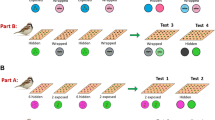Summary
House flies, Musca domestica, respond to visual contrasts on the substrate if a resource is associated with the contrasting patterns. Visible resource patch boundaries serve as a signal to flies that they are about to leave a rewarding patch. Searching flies respond to such visual information by walking along the resource patch boundary and turning back into the patch at its edge. This edge detection and response serve as a mechanism for flies with visual cues to stay in a rewarding patch and locate more resources within it. The intensity of their response correlates with the quality of the resource. In the absence of visual cues, patch shape affects foraging success; flies find more resources in circular than in linear resource distributions. The effects of visual cues, however, render patch shape unimportant. Various substrate contrasts are effective as resource information for flies: dark (e.g., green) figures on bright (e.g., white) backgrounds or bright figures on dark backgrounds. Responses to substrate contrasts measured in this study indicate that, over the short term, house flies can learn a visual cue associated with a food source.
Similar content being viewed by others
References
Bell WJ (1985) Sources of information controlling motor patterns in arthropod local search orientation. J Insect Physiol 31:837–847
Bell WJ (1990) Searching behavior patterns in insects. Annu Rev Entomol 35:447–467
Bernays EA, Wrubel RP (1985) Learning by grasshoppers: association of colour/light intensity with food. Physiol Entomol 10:359–369
Couvillon PA, Bitterman ME (1987) Discrimination of color-odor compounds by honeybees: tests of a continuity model. Anim Learn Behav 15:218–227
Dethier VG (1957) Communication by insects: physiology of dancing. Science 125:331–336
Dethier VG (1963) The physiology of insect senses. John Wiley & Sons, New York NY
Fromm JE, Bell WJ (1987) Search orientation of Musca domestica in patches of sucrose drops. Physiol Entomol 12:297–307
Fukushi T (1976) Classical conditioning to visual stimuli in the housefly, Musca domestica. J Insect Physiol 22:361–364
Fukushi T (1983) The role of learning on the finding of food in the searching behaviour of the housefly, Musca domestica (Diptera: Muscidae). Entomol General 8:241–250
Fukushi T (1985) Visual learning in walking blowflies, Lucilia cuprina. J Comp Physiol A 157:771–778
Fukushi T (1989) Learning and discrimination of coloured papers in the walking blowfly, Lucilia cuprina. J Comp Physiol A 166:57–64
Gould JL (1985) How bees remember flower shapes. Science 227:1492–1494
Gould JL (1986) Pattern learning by honey bees. Anim Behav 34:990–997
Hirsch J, Holliday M (1988) A fundamental distinction in the analysis and interpretation of behavior. J Comp Psychol 102:372–377
Jander R (1971) Visual pattern recognition and directional orientation in insects. Ann NY Acad Sci 188:5–11
Jander R (1975) Ecological aspects of spatial orientation. Annu Rev Ecol Syst 6:171–188
Jeanrot N, Campan R, Lambin M (1981) Functional exploration of the visual field of the wood-cricket, Nemobius sylvestris. Physiol Entomol 6:27–34
Kevan PG, Lane MA (1985) Flower petal microtexture is a tactile cue for bees. Proc Natl Acad Sci USA 82:4750–4752
Lambin M (1984) Retinal scanning and visual inputs in freely walking crickets. Physiol Entomol 9:181–190
Lehrer M, Srinivasan MV, Zhang SW (1990) Visual edge detection in the honeybee and its chromatic properties. Proc R Soc Lond B 238:321–330
Mayor KL, Aracena JM, Bell WJ (1987) Search duration of Drosophila melanogaster on homogeneous sucrose patches: relative effects of starvation period, sucrose concentration and patch size. J Ethol 5:67–74
Nuboer JFW (1986) A comparative view on colour vision. Netherlands J Zool 36:344–380
Varjú D (1975) Stationary and dynamic responses during visual edge fixation by walking insects. Nature 255:330–332
Wehner R (1981) Spatial vision in arthropods. In: Autrum H (ed) Vision in invertebrates. (Handbook of sensory physiology VII/6C). Springer, Berlin Heidelberg New York, pp 287–616
Wehrhahn C (1984) Ocellar vision and orientation in flies. Proc R Soc Lond B 222:409–411
White J, Tobin TR, Bell WJ (1984) Local search in the housefly Musca domestica after feeding on sucrose. J Insect Physiol 30:477–487
Author information
Authors and Affiliations
Rights and permissions
About this article
Cite this article
Conlon, D., Bell, W.J. The use of visual information by house flies, Musca domestica (Diptera: Muscidae), foraging in resource patches. J Comp Physiol A 168, 365–371 (1991). https://doi.org/10.1007/BF00198355
Accepted:
Issue Date:
DOI: https://doi.org/10.1007/BF00198355




